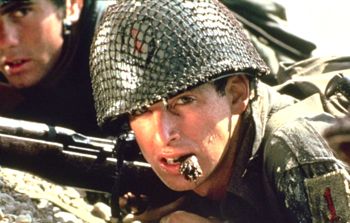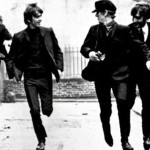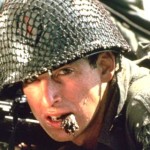 Sam Fuller’s “The Big Red One,” a lost platoon of a movie that was cut to shreds upon initial release, finally came home to a hero’s welcome in 2005 with the release of “The Reconstruction.”
Sam Fuller’s “The Big Red One,” a lost platoon of a movie that was cut to shreds upon initial release, finally came home to a hero’s welcome in 2005 with the release of “The Reconstruction.”
What appeared to theatrical audiences of 1980 as a ragtag chronicle of young men at war now stands tall as one of the dozen or so great movies about World War II, thanks to a intensive effort that returned about an hour of footage to the film.
Fuller never saw his movie in its glory. He died in 1997, still fuming over the treatment “The Big Red One” received upon theatrical release at the hands of Lorimar.
Sadly, that war isn’t over. The tough-guy director no doubt would be apoplectic to learn that Warner Bros. has in 2014 rereleased his combat movie to Blu-ray, reserving the HD upgrade for the botched theatrical version — but leaving the reconstruction behind in standard def.
Buyers of the new “The Big Red One” get the hacked-up theatrical on a Blu-ray disc and the extended version only on a DVD. Special features are the same. It gets worse. Incredibly, the Blu-ray’s cover features a “Cannes classics” logo — referencing the 2004 festival screening of the reconstruction.
Owners of the May 2005 DVD are advised to sit tight, hoping Warner Home Video will stop making excuses about conversion problems and economics, and get Fuller’s expanded work onto the format of the present (the studio is “not in a position to remaster the re-constructed version for Blu-Ray due to costs”). Or turn over the project to the Criterion Collection, which makes things like this happen.
As for the legendary four-hour cut of “The Big Red One” — forget it.
 The revived “Big Red One” had its own limitations, starting with the absence of Fuller. “We can’t pretend this was a director’s cut,” cautions reconstruction producer Richard Schickel. Armed with newly found footage but no surviving directions, Schickel’s men had to get inside the mind of Fuller — by all accounts a scary place.
The revived “Big Red One” had its own limitations, starting with the absence of Fuller. “We can’t pretend this was a director’s cut,” cautions reconstruction producer Richard Schickel. Armed with newly found footage but no surviving directions, Schickel’s men had to get inside the mind of Fuller — by all accounts a scary place.
Warner’s 2005 “The Big Red One: The Reconstruction” was a two-disc special edition. The widescreen (1.85:1) images are soft but fairly good considering the age and relatively low budget of the original film. The audio, rebuilt with contemporary effects pumping up the din of combat, races about the soundstage — it’s powerful and disorienting.
Fuller, best known these days for films noir like “Pickup on South Street” and twisted B-movies like “Shock Corridor,” fought in the European theater in WWII. His star, Lee Marvin, campaigned in the Pacific. “He was wise and he was experienced and he was cold,” Fuller said of Marvin, who played a three-stripe sergeant leading his young charges across North Africa and Europe.
“It was just so cool to see these two guys, who lived this for real, back in the moment,” recalls Robert Carradine, who played the young Fuller character in “Big Red One.” The DVD set features the recollections of the actors who played Fuller’s invincible and inseparable “four horsemen” — the lucky few who survived the campaigns as younger replacement troops died around them. (All four actors do killer impersonations of the comically gruff Fuller.)
Fuller relived his Army days by directing his youthful stars with a gun in each hand. “He seemed to believe that sudden death was extremely close to us,” Schickel says. A lot of what was returned to the film, he says, were “Sam absurdities,” such as a scene in which a Nazi orderly kisses the wounded Marvin full on the mouth, or one in which the sarge spanks a boy sniper instead of killing him.
“Whoever was editing this film made some weird choices,” Schickel says. Most of the damage came when Lorimar seized control of the film from Fuller.
“I don’t know if I could articulate how crushed we were when we saw the screening of the finished movie,” says Carradine, who gladly did publicity in 2004 on behalf of the reconstructed film and the DVD.
One scene returned to the film, mostly as a tribute, shows Fuller playing a combat movie cameraman. (Fuller had shot footage in his war days, including scenes inside a liberated death camp that are shown on the DVD.)
An excellent 2004 featurette on the reconstruction — they never call it a restoration — runs 50 minutes. Bryan McKenzie, editor of the new version, tells how an extended promo reel provided images that completed some of the key scenes. About 70,000 feet of camera originals were found in a Kansas City vault, set aside for a quarter century; the negative was cleaned frame by frame.
Still, after the roundup of raw materials, it was obvious that the legendary four-hour cut of “The Big Red One” was not to be found. “I think it made a good story, but I don’t think it exists,” Schickel says.
The new version, Schickel says, is “as close as humanly possible” to the movie Fuller would have made. The director’s daughter, seen waving a fat cigar in the family tradition, agrees.
Schickel does a feature-length DVD commentary that stays in step for the most part, but the film historian does sound under the weather. (The talk is nowhere as good or focused as his work on the restored “The Good, the Bad and the Ugly.”)
Other DVD extras include alternate scenes, a breakdown of key scenes, a War Department film about “The Fighting First” and the critical 1980 promo reel.
More war movies on Blu-ray (reviews):
Check out Glenn Abel on Google+



Leave a Reply